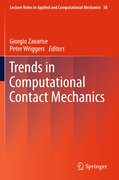
The subject of Computational Contact Mechanics has many facets. Its main impact lies in the transfer of knowledge form theoretical research to applied sciences, and from there to industry. The application fields are literally countless, ranging from classical engineering to biomechanics and nano-sciences. The remarkable increase of computer power in recent years has been instrumental inenabling the development of simulation-based analysis in current design activity. This still involves tremendous effort in research, which focuses on, for example, multi-field and multi-scale problems, algorithmic robustness, and geometrical accuracy. Moreover, several aspects of Contact Mechanics, Debonding and Fracture Mechanics, have been combined to offer new enhanced possibilities to the computer simulation of complex phenomena. With these contributions of prominent scientists, this book offers a wide overview on the ongoing research at the highest level in the field. Recent trends in Computational Contact Mechanics. Scientific edited outcome of the 1st Int. Conference on Computational Contact Mechanics ICCCM 09 held at Lecce Italy, Sept. 2009. Written by leading experts in the field INDICE: From the content: Contact Modelling in Entangled Fibrous Materials. 3D Contact Smoothing Method Based on Quasi-C1 Interpolation. On a Geometrically Exact Theory for Contact Interactions. Finite Deformation Contact Based ona 3D Dual Mortar and Semi-Smooth Newton Approach. The Contact Patch Test for Linear Contact Pressure Distributions in 2D Frictionless Contact.
- ISBN: 978-3-642-22166-8
- Editorial: Springer Berlin Heidelberg
- Encuadernacion: Cartoné
- Páginas: 356
- Fecha Publicación: 19/06/2011
- Nº Volúmenes: 1
- Idioma: Inglés
